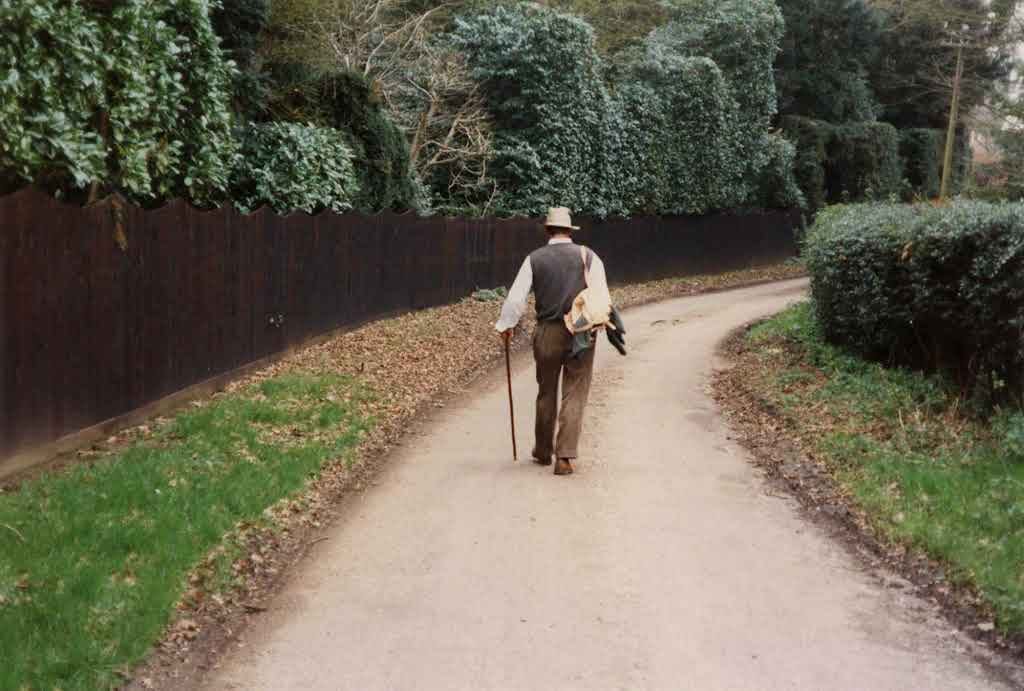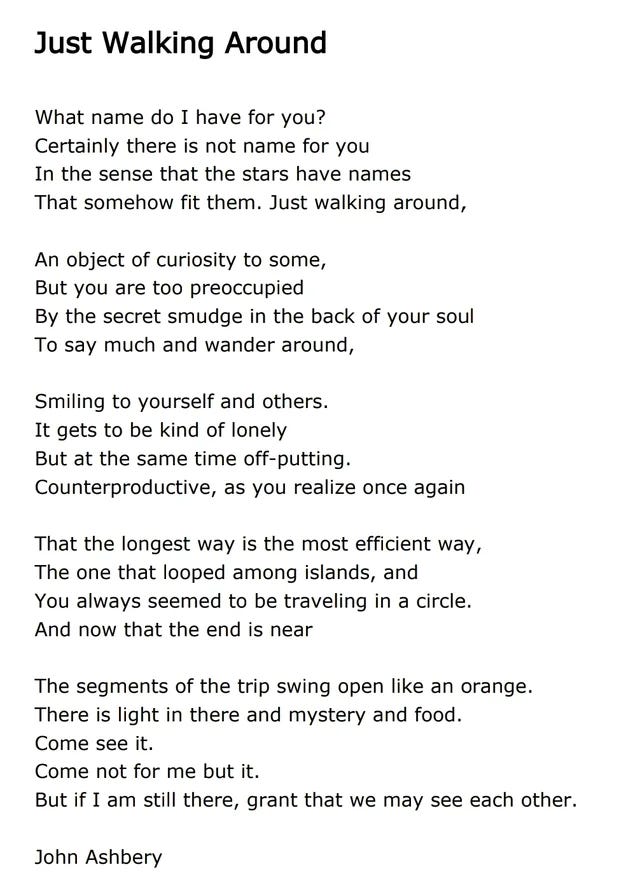Take Your Time
In Praise of the Strolling Thought
Every morning, I used to walk three miles—a loop near a lake in a state park, watching the seasons unfold in their movements. My wife would sometimes join and recite lines from Ted Kooser’s poetry, noticing the changing light, the first frost, the return of birds. The walk was therapeutic in the ancient sense: therapeia—care, cultivation, tending. The walk was how I tended to myself. It was a disciplined practice, which is to say it required discipline to maintain and discipline to experience. I had to get up. I had to go.
But once walking, a different kind of discipline emerged—the discipline of attention. Walking heightens the senses. You notice the particular quality of morning light in October versus November. You hear the difference between spring birds returning and fall birds preparing to leave. Your body becomes an instrument for perceiving the world’s subtle variations. The walk established a rhythm for the day. Not in some mystical sense, but practically: my thoughts could unfold at walking pace. Three miles gave me time to move from the night’s residue into the day’s readiness. To be alone with what was forming in my mind.
I say “I used to” because the practice has slipped away slightly. Work I love has displaced it. The pull of building something, of responding to the demands that come with creating, has shifted my mornings. I recognize the importance of the work. But I also recognize what I’m missing in the displacement. I hope to return to the rhythms of walking again soon.
Movement and Thought
Kant was a famous walker. People would tell the time by observing him on his regular stroll, which he executed at the same time each day. The German-British writer, W.G. Sebald wrote a powerful book about walking the countryside called Rings of Saturn. Walter Benjamin and Flaubert likewise write in praise of the flaneur, the idling walker, who roams city streets, as a redemptive figure.
Maria Montessori, my own inspiration, belongs this tradition. She understood movement as constitutive of thought.
From Rousseau’s Emile learning through direct encounter with nature, to Thoreau walking the woods around Concord as philosophical practice, there runs a thread recognizing that walking sets a pace at which genuine thought becomes possible. Walking can reveal different temporalities.
Montessori’s contribution was a practice of movement in learning. She built environments where this observation could be lived. In her classrooms, children are free to explore, to move about, on their own accord, within the conditions of the environment. The child who rises from the mat, walks across the room, selects the golden beads, carries them carefully back—this sequence of movements is the thought taking form.
Montessori created spaces where children could move at their own pace, follow their own rhythms, encounter materials when genuine interest arose rather than when a schedule dictated. While traditional classrooms mandate that children stay seated in neatly organized desks, she liberated movement. As Montessori wrote, “The essential thing is for the task to arouse such an interest that it engages the child’s whole personality.” But the prepared environment requires something we’ve become unaccustomed to: patience, cultivation, germination. The possibility of wandering without immediate purpose. A child might spend ten minutes watching dust motes in sunlight. An adult might take three miles to arrive at a single clear thought. Both require the same condition: freedom from the demand for immediate productivity, immediate response, immediate results. The trick is, when desire is allowed to pursue its own interests, there is no need to create artificial incentives or constraints. In many respects, our world has become the opposite of a prepared environment. It is noisy, crowded with demands for instantaneity. These demands are amplified by manufactured social mechanisms.
Education itself now bathes in currents of immediate gratification, technology always at the ready, the constant pressure to stimulate, engage, capture attention. We have mistaken stimulation for encounter. There is another way to think about this.
Encounter as Provocation
What Montessori fostered in the creation of the prepared environment, Deleuze articulated philosophically: “Something in the world forces us to think. This something is an object not of recognition but of a fundamental encounter.” Encounter is provocation. It disrupts. It demands. But—and this is what we’re losing—genuine encounter requires the very conditions Montessori identified. It requires time. Space to move at your own pace. The freedom to return, to circle back, to wrestle with what refuses easy comprehension. To encounter another’s thought is not to consume it, to extract its useful bits, to quickly agree or disagree. It is to assume that thought, to inhabit it, to let it work on you. This is what I mean by being alone with someone else’s thoughts. Reading Nietzsche or Deleuze or Montessori herself is encounter. It requires the same sustained attention, the same patient wrestling, as any genuine relationship. You must give it time to unfold. You must allow yourself to be changed by what you’re reading, not simply confirmed in what you already think. When everything demands immediate response—the notification, the email, the question that could wait but won’t—there is no space for incorporation. We skim. We react. We move on. The deeper work of assuming someone else’s thought, of letting it provoke genuine thinking rather than mere opinion, requires a kind of solitude that has become almost unavailable. Quietude is not the absence of sound. It is the presence of space for thought to move at its own pace. It can be found in walking. It can be found in movement.
The Walking Pace of Thought
Nietzsche knew this in his body. His philosophy was inseparable from his walks through the Swiss mountains, along the Mediterranean coast, through the forests around Sils Maria. “Sit as little as possible,” he insisted, “give no credence to any thought that was not born outdoors while one moved about freely—in which the muscles are not celebrating a feast, too.” He understood that walking doesn’t merely accompany thought—it generates it. “All truly great thoughts are conceived by walking,” he wrote. Not because walking produces clever ideas, but because walking establishes the pace at which genuine thought unfolds. The rhythm of footsteps, the breath synchronized with movement, the landscape slowly revealing itself—this is the tempo of rumination.
Rumination. The word comes from ruminant animals who chew, swallow, regurgitate, and chew again. It describes the slow, patient work of digesting what cannot be quickly consumed. Nietzsche’s walking was philosophical rumination—returning to the same questions, the same provocations, letting them work on him over miles and months and years. Over mountains. In many respects, I fear we are at risk of losing touch with the conditions for rumination. The demand for immediacy has a tendency to crowd out the walking pace of thought. We are asked to respond now, to have opinions instantly, to process information at speeds that often prevent incorporation.
Our educational system, and the priorities we endorse, reflects this. We bathe children in stimulation. We provide constant access to information, which can easily be misconstrued as wisdom. We have optimized for speed when what we might actually need is the patient discipline of encounter. AI offers us something unprecedented—instant access to articulated thought on any subject. If you haven’t already, try it. We can ask a question and receive, in moments, what appears to be the product of rumination: nuanced analysis, connections across disciplines, careful reasoning. Thinking says the spinning notification.
But what kind of encounter is this? Does the speed at which AI generates responses change what it means to wrestle with ideas? Or does it simply reveal more starkly the choice we’ve always had: to consume or to incorporate, to react or to ruminate? The technology itself doesn’t answer these questions. It intensifies them.
We now have tools that can produce thought-like outputs without thought’s natural rhythm. Or, are they the natural rhythms of thought? Whether this deepens or destroys the conditions for genuine encounter depends not on the tool but on what we choose to do with the space we create around it.
What are we losing when we lose quietude? The space to be alone with thought, to walk with an idea until it reveals itself, to wrestle with another’s thinking until it becomes, in some sense, your own?
There’s so much false urgency afoot, when the ability to craft your own philosophy takes time. May we never lose the capacity for encounters.
P.S.—Enjoy this delightful poem by John Ashbery called Just Walking Around.






